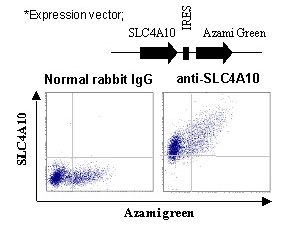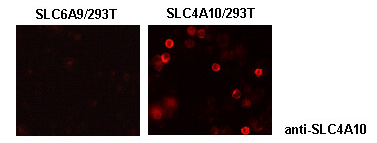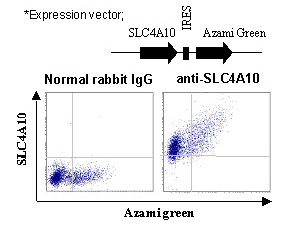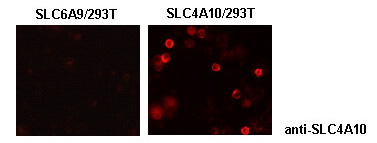Anti-SLC4A10 (NCBE) (Human) pAb
| Code | Size | Price |
|---|
| MBL-BMP071 | 100 ul | £323.00 |
Quantity:
Prices exclude any Taxes / VAT
Overview
Host Type: Rabbit
Antibody Isotype: IgG
Antibody Clonality: Polyclonal
Regulatory Status: RUO
Target Species: Human
Applications:
- Flow Cytometry
- Immunocytochemistry (ICC)
- Immunohistochemistry (IHC)
Shipping:
4°C
Storage:
-20°C
Images
Documents
Further Information
Applications:
FCM - 1:500 ICC - 1:500 IHC - 1:1000 (Heat treatment required for paraffin)
Background:
Members of the solute carrier family 4 are classified as bicarbonate transporters, which transport chloride across membranes in order to regulate intracellular pH. SLC4A10/NCBE is predominantly distributed in the brain. Mice lacking slc4a10 have rather small brain ventricles and increased seizure threshold. In humans, disruption of the gene for SLC4A10/NCBE has been observed in a mentally retarded patient with complex partial epilepsy. Therefore, SLC4A10/NCBE may participate in the regulation of neuronal pH and neuronal excitability in the central nervous system.
Formulation:
100 ul volume of PBS containing 50% glycerol, pH 7.2. No preservative is contained.
Gene IDs:
Human: 57282 Mouse: 94229
Immunogen Translated:
Synthetic peptide derived from human SLC4A10
Reactivity:
This antibody can be used to stain endogenous antigen in paraffin embedded human tissues including the cerebrum and cerebellum by Immunohistochemistry. The reactivity has been confirmed by Immunocytochemistry and intracellular Flow cytometry to detect the full length of human SLC4A10 transiently expressed in HEK 293T cells.
Shelf Life:
1 year
Source:
This antibody was affinity purified from rabbit serum. The rabbit was immunized with a synthetic peptide derived from human SLC4A10.
Target:
SLC4A10/NCBE
References
1)
Gurnett, C. A., et al., Arch. Neurol. 65, 550-553 (2008)
2)
Jacobs, S., et al., PNAS 105, 311-316 (2008)
3)
Parker, M. D., et al., J. Biol. Chem. 283, 12777-12788 (2008)
4)
Yano, H., et al., Cytogenet. Cell Genet. 89, 276-277 (2000)








